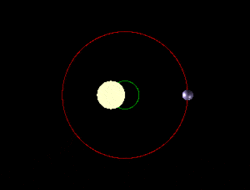Create a free profile to get unlimited access to exclusive videos, sweepstakes, and more!
A new nearby super-Earth’s atmospheric secrets may soon be revealed

Astronomers have found a super-Earth around a nearby star that will be perfect for future observations to determine what’s in its atmosphere. This is a very cool and important find.
The star is called Gliese 486, and it’s a red dwarf, a low-mass and dim one about 27 light years from Earth. That’s very close to us in galactic terms; only about 200 stars are within that distance. Gliese 486 is about a third the mass and diameter of the Sun, and shines with only about 1% of the Sun’s brightness. Even though it’s one of the closest stars to us it’s so dim you need a decent telescope to see it at all.
They observed it for five years (from 2016 to 2020) with CARMENES (or Calar Alto high-Resolution search for M dwarfs with Exo-earths with Near-infrared and optical Echelle spectrographs, so you can see why they go with the acronym). This is a project to observe nearby red dwarfs (called M-type stars by astronomers) and look for Earth-sized planets orbiting them.
If a star has a planet orbiting it, they really both orbit their center of mass. As the star makes a circle, for half the orbit it approaches us and the other half it recedes, so we see a periodic Doppler shift in its light. Red dwarfs are great for this because they have a low mass, so a planet’s gravity has more of an effect.
Astronomers found that the star underwent a shift with a 1.467-day period, indicating a planet in a close orbit. They found the planet has a mass of 2.8 times that of Earth, and orbits just 2.6 million kilometers from it. That’s close; just 6 times farther than the Moon is from Earth!
Happily, this planet also transits the star, literally passing directly in front of it once per orbit, blocking a bit of its light. That gives its size, which is 1.3 times the diameter of Earth.
With its size and its mass we can get the all-important density, which is 7 grams per cubic centimeter. That’s crucial because that tells us something about what the planet is made of. A gas giant like Jupiter has a density around 1. An ocean planet would have a density around 2 or 3 (assuming it has a rocky/metal core). Earth is mostly rock and metal and has a density of 5.5. So Gliese 486b, as the planet is called, is a little denser than Earth.
Planets up to about twice Earth’s size are called super-Earths. This one falls right into that category.
Earth-like, though, it is not. The star may be dim and cool compared to the Sun, but from 2.6 million kilometers it’s like sticking your head in an oven. Or a kiln: The planet’s surface temperature is probably around 430°C (800° F), or about the same as Venus. Not enough to have a molten surface, but not a place you want to hang around on either.
But this is great news! We don’t know a lot about the atmospheres of super-Earths, and this planet provides a chance to get a look at one. When it transits the star, some light will go through its atmosphere on the way to Earth. Atoms and molecules in the atmosphere absorb very specific wavelengths (colors) of light, allowing us to ID them. Also, the planet is hot enough that some of those same molecules will glow, emitting light at specific wavelengths.
Most of this will happen in the infrared, so it’s a bit of a tough observation to do right now. However, the James Webb Space Telescope, which is currently scheduled to launch in October 2021*, hits the sweet spot for observations like this. The star is relatively bright for such an observation, so it should be possible to take a decent look at this planet’s atmosphere (assuming it has one) pretty quickly. Hopefully, planets like this will be priority targets.
The paper had an interesting statistic in it that I hadn’t seen before. Within 10 parsecs (32.6 light years) of the Sun there are 357 main sequence stars — ones fusing hydrogen into helium in their cores, so in general like the Sun (that number is accurate as of 2018 but is unlikely to change much). Of these, 283 are M-type red dwarfs. That’s about 80%! Of these stars, there are 40 systems that we know of with a total of 80 planets (many stars have more than one known planet).
Of those, 50 planets orbit 30 red dwarf stars. In other words, looking near Earth, most planets orbit red dwarfs, and many red dwarfs host multiple planets. That’s probably true throughout the galaxy.
Clearly, if you want to find lots of planets, red dwarfs are the place to look. This new work supports that, and shows there’s still a lot more we can find out about them, too.
*JWST has been delayed so many times for so many reasons that I wouldn’t bet on any particular launch date. However, it recently passed an important pre-launch milestone, so a launch in 2021 seems feasible.





























